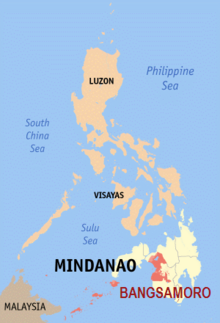Comprehensive Agreement on the Bangsamoro

Areas in red constitute the proposed Bangsamoro political entity
|
|
| Context | Part of a series of peace agreements between the Government of the Philippines and the Moro Islamic Liberation Front seeking resolution to the Moro conflict |
|---|---|
| Signed | 27 March 2014 |
| Location | Malacañan Palace, Manila, Philippines |
| Signatories |
|
| Parties |
|
The Comprehensive Agreement on Bangsamoro (CAB) is a final peace agreement signed between the Government of the Philippines and the Moro Islamic Liberation Front on 27 March 2014 at the Malacañan Palace in Manila. Under the agreement, the Islamic separatists would turn over their firearms to a third party, which would be selected by the rebels and the Philippine government. The MILF had agreed to decommission its armed wing, the Bangsamoro Islamic Armed Forces (BIAF). In return, the government would establish an autonomous Bangsamoro. Power sharing was a central point to the autonomy redesign.
The current ARMM charter lists 14 areas that are outside the powers of the regional legislature. In this comprehensive peace agreement, the parties lists 81 powers categorized into reserved for the central government, exclusive to the Bangsamoro, and concurrent with or shared by the two sides for power sharing. Of the 81 powers, 58 are devolved to the Bangsamoro, nine are reserved to the central government, and 14 are shared. The Framework Agreement on the Bangsamoro and Four annexes, namely on Transitional Arrangements and Modalities, Revenue Generation and Wealth Sharing, Power Sharing and Normalization, together with the Addendum on Bangsamoro Waters, will be included in the comprehensive agreement. The Armed Forces of the Philippines has raised red alert status on 24 March in preparation for the event. Philippine President Benigno Aquino III, MILF chair Hadji Murad Ibrahim, and Malaysian Prime Minister Najib Razak are among the key people expected to be present at the signing of the agreement.
In pursuit of their goal of liberating Bangsamoro, the MNLF engaged the government forces in extensive armed collisions, peaking in the early 70s when the rebels’ blitz-like operations brought them control of a substantial number of municipalities surrounding Cotabato City and its airport complex. This prompted the Marcos regime to beef up military presence by deploying almost three-fourths of the army in most Muslim parts of Mindanao. Things took a different turn in 1976 when Libyan leader Muammar Gaddafi brokered an agreement that led to the signing of the Tripoli Agreement introducing the concept of an autonomous Muslim region in Mindanao. On 1 August 1989, under the mandate of the new 1987 Constitution,Congress enacted Republic Act 6734 authorizing the creation of the Autonomous Region in Muslim Mindanao (ARMM). However, out of the 13 provinces and 9 cities that participated in the plebiscite, only the provinces of Lanao del Sur, Maguindanao, Sulu, and Tawi-Tawi opted to become part of the ARMM. The ARMM was formally established on 6 November 1990.
...
Wikipedia
